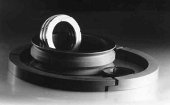Carbon materials for radial
seals
 Generalities
Generalities
Radial seals are used to seal components in rotation or translation. They
can be with or without contact.
Carbon material B14 is used for its selflubricating properties and
corrosion resistance to the sealed media. Radial carbon seal rings are
usually made from several segments.
Contact Seals
These assures the smallest leakage because of the permanent contact between
sealing ring and shaft due to the radial forces which act on segments.
The wear is compensated by the decreasing of the gaps between the
segments. To increase the efficiency of the seal, more sealing
rings with staggered joint gaps can be fitted in the same chamber.
The rings are set in the chamber and to one another with pins to prevent
rotation.
Gap Seals
Sealing rings without contact are used in seals where the wear of the
rings is expected to be higher.
Although they are alike as the contact seals, they are designed in that
way, that at the beginning of the working period they work like a contact
seal, but after the running in period when the joint gaps disappear, the
wear of the bore stops, and a very small gap is established (theoretical
zero, practical in accordance with the maximal imperfections of
machining and assembly).
One Piece Carbon Gap
One piece carbon gap seals are generally shrunk into a metal
holder. In this case, fit plays are maintained even on the operating
temperature, because of the shrinkage stress the carbon ring expands with
a little smaller coefficient of thermal expansion than that of the metal
holder.

Labyrinth Seals
Labyrinth type seals made
of carbon materials, present grooves of different forms in
the bore of the ring. Because of the selflubricating property gripping
danger is reduced, so a smaller clearance can be kept
comparative with other materials.
Note
Segment gap or contact
seals are delivered as complete rings. Usually
the segments are marked for eliminate the
risk of wrong fitting. For keeping the segments together,
they have peripheral grooves in which spiral, tension springs
are fitted which assures also part of the contact pressure. According
to the functioning requests the end of segments may have different forms,
from simple radial split to overlapped ones.